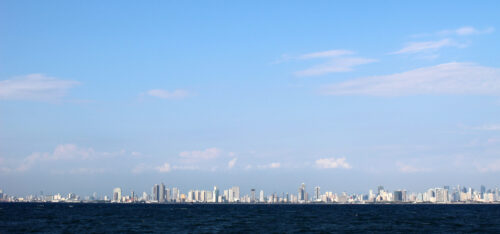Combating Air Pollution for Clean Air and Blue Skies

Air pollution is a grave threat to global health and well-being of everyone. More than six million people die each year from causes related to air pollution—a number that is more than HIV/AIDS, malaria, and tuberculosis combined. A number that is also more than the current number of deaths from the COVID-19 pandemic.
The vast majority of those deaths—nearly 80 percent—occur in low- and middle-income countries; mainly in Asia, Africa, and the Middle East. Under “business as usual,” projections, the estimated number of deaths from air pollution could increase by more than 50 percent by 2050, resulting in a staggering 10 million deaths per year.
But hope is not lost—these deaths are avoidable.
Reducing air pollution requires big changes in how economies are powered, how cities and infrastructure are designed, and how natural capital like forests and land are managed. On the second annual International Day of Clean Air for blue skies, the U.S. Agency for International Development (USAID) reaffirms alongside the international community its commitment to prioritizing healthy air for all.
Air Pollution & Climate Change
Reducing air pollution also combats another urgent global crisis: climate change. Air pollution contributes directly to climate change, and the causes of air pollution are often the same as the causes of climate change.
Short-lived climate pollutants—such as black carbon and methane—persist in the atmosphere and are linked with both health effects and near-term warming of the planet. Far too little attention and funding is going toward the implementation of solutions to significantly reduce these short-lived climate pollutants and overall air pollution. Afterall, air pollution does not respect national borders, and it costs the world economy trillions¹ of dollars in welfare losses worldwide. Actions that address air pollution will pay for themselves in terms of avoided health costs, climate impacts, as well as lost wages.
The good news on air pollution and climate change is that solving one can help solve the other. Key solutions for reducing carbon emissions—curbing the extraction and burning of fossil fuels—often provide the greatest improvements in air quality for public health.
But despite the alarming health impacts of air pollution and its role in the global climate crisis, little progress has been made on reducing air pollution in low- and middle-income countries.
Indeed, the trend lines are too often going in the wrong direction. Rapidly urbanizing cities in the developing world are at the center of the air pollution crisis. They are also the places where the most innovative and impactful solutions are being developed. But cities are complex systems — and the causes of, and solutions to, air pollution can vary greatly from city to city, region to region.
Oftentimes, the catalyst for governments to solve their local climate crisis is spurred by air quality. Air quality affects everyone’s health and human development—and when negative externalities such as poor air quality are detrimental to an entire cities’ population, this is when local leaders and businesses make real changes to their policies. The demand for clean air and improved health is what drives political action on climate.
Solving this crisis will require global leadership and local action; private enterprise and civic commitment; advanced technology and individual behavior change. Policymaking is key, too—joint air quality and climate planning and implementation is the crux for developing countries. To solve this immense challenge, cooperation and partnerships at all levels—global and local, as well as public and private, is necessary.
USAID’S Approach to Air Pollution & Climate Change
Climate change is a key priority for USAID, and targeted air pollution initiatives are an integral part of achieving the Agency’s climate goals USAID’s partner countries are disproportionately affected by climate change and are already facing the impacts of a warming planet. Women, children and vulnerable communities are further disproportionately affected within these countries. At the same time, these same countries are integral to limiting climate change.
Earlier this year, USAID launched the Clean Air Catalyst program, a new global consortium made up of a number of organizations with expertise in air quality, environment, public health, energy, and governance coming together to apply locally-tailored solutions that can be scaled globally to tackle air pollution. Through the project, this coalition teams up with local problem solvers, municipal governments, and other key players to identify, test, source, and accelerate solutions. The initial pilots in Indore, India and Jakarta, Indonesia are underway, with the goal of replicating successful approaches in additional cities.
Simultaneously, USAID is creating a new climate strategy set to launch this upcoming fall. Air pollution and urban development are key facets of achieving the climate goals that the Agency upholds. The strategy will guide USAID’ effort through 2030 to achieve ambitious, targeted, and equitable results in the fight against the climate crisis.
USAID is implementing programs and strategies such as these because it’s not only the right thing to do, but the Agency knows that the U.S. cannot achieve the goals of the Paris Climate Agreement or the SDGs without developing locally-tailored solutions to improve and maintain clean air.

